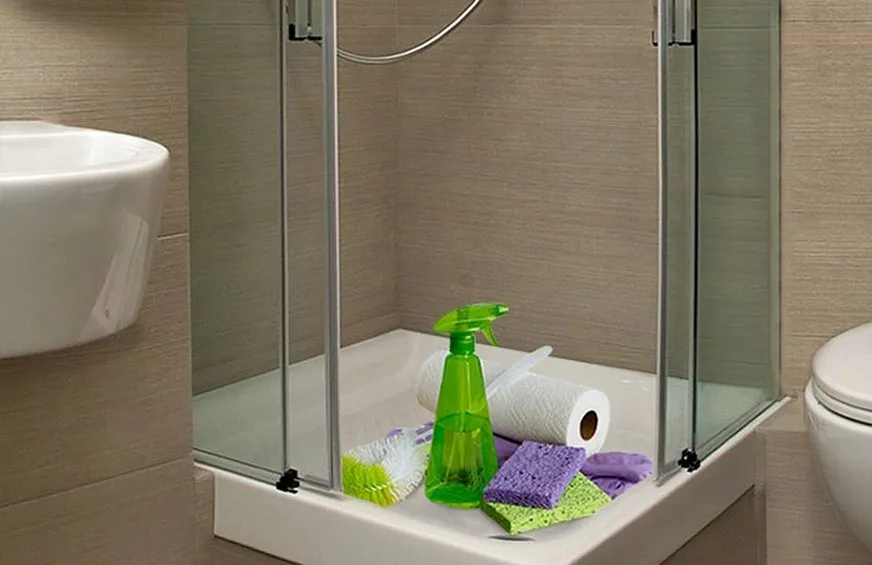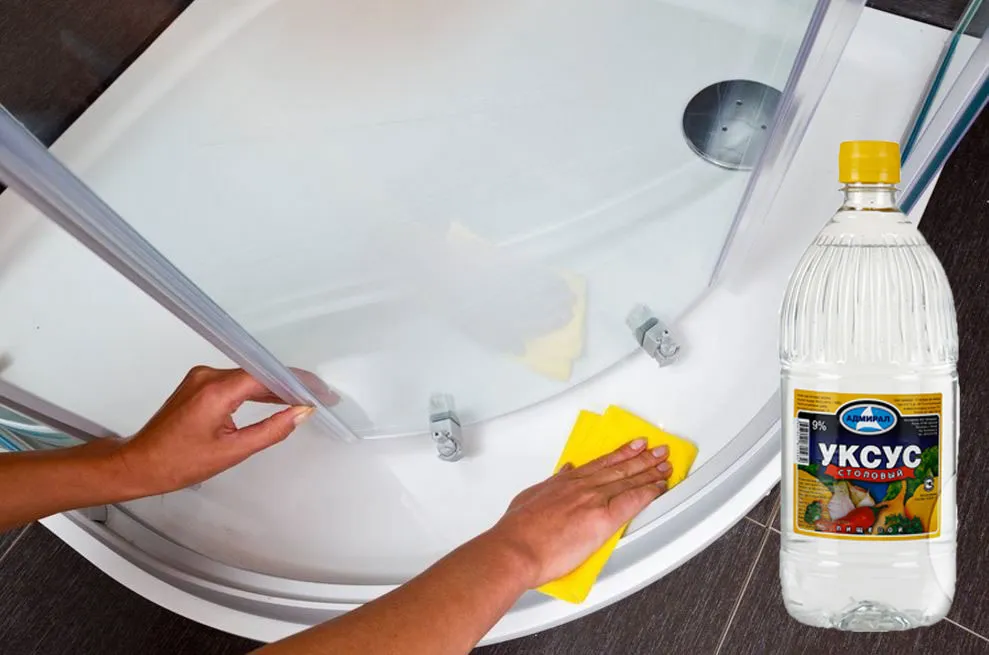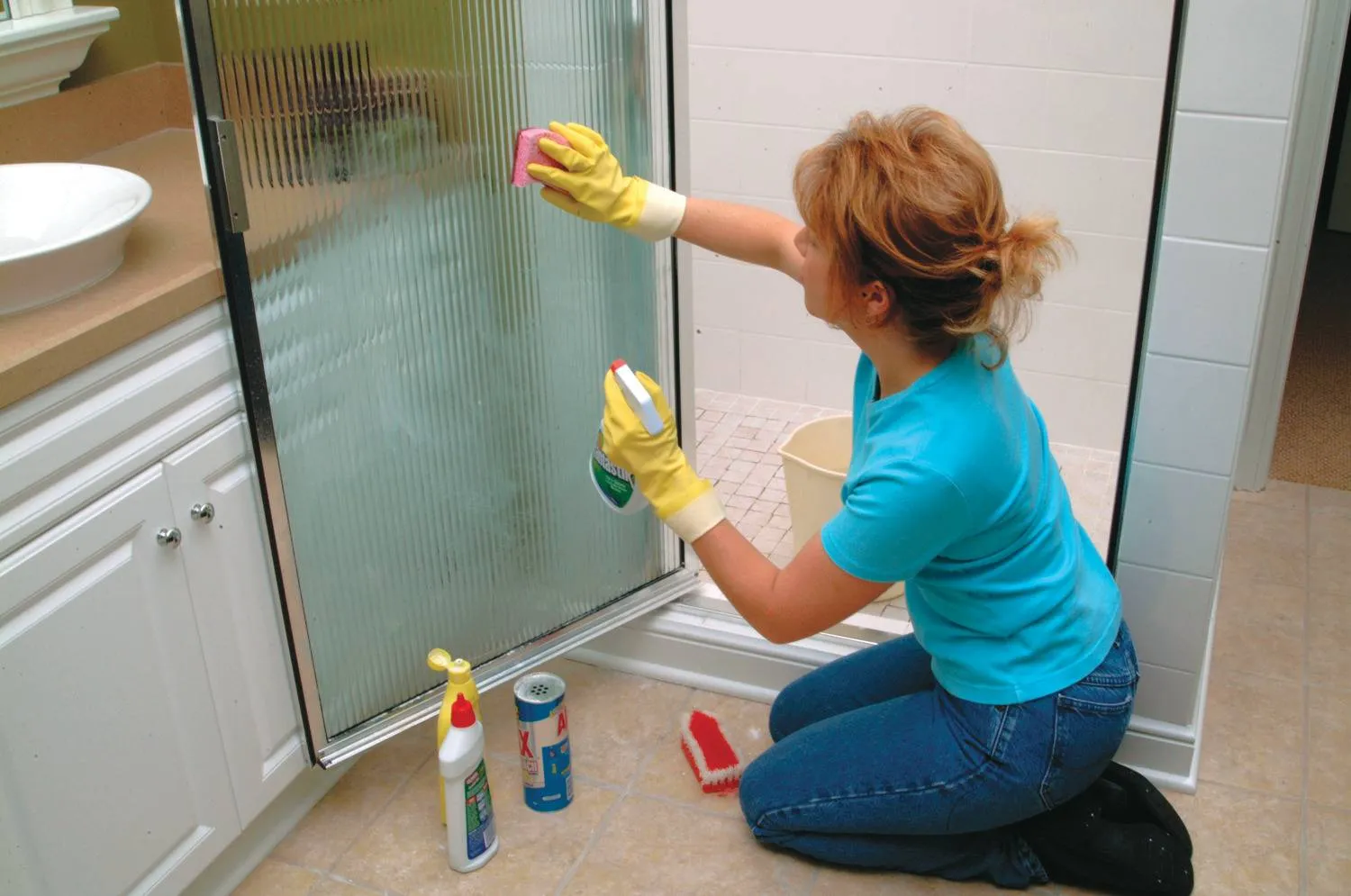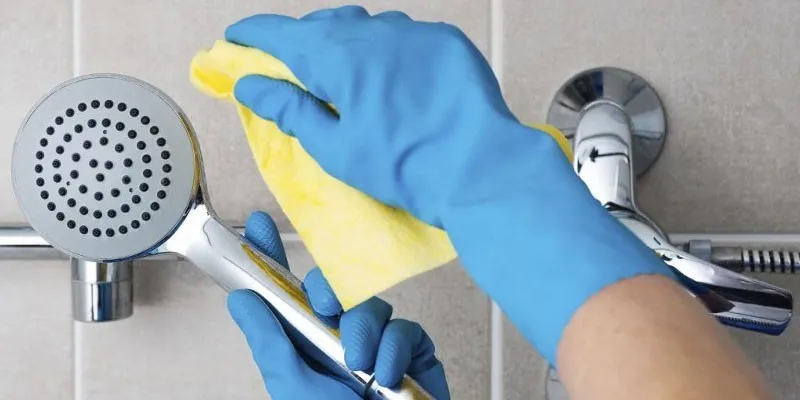How to clean a shower stall? Have you thought about this more than once? They did the right thing because this plumbing needs special care. With frequent use of the shower stall, stains and deposits (soap or limescale) appear on its surface. There are a large number of ways to get rid of them, but not all of them are effective. It is worth familiarizing yourself with the existing options that will help cope with contamination without damaging the shower stall. It is important to note that each element requires its own approach.

How to clean a shower stall
Cleaning the shower tray
To decide what you can use to clean the shower stall, you need to figure out which part of it is most susceptible to contamination. The most problematic is the tray, on which limescale accumulates. It appears due to salts that are released from the water. May appear on various surfaces. Be it plastic, metal or glass. On dark-coloured products, the coating will be visible after just a few showers.
The pallets of modern cabins are made from different materials, but the most common is acrylic. Without timely care, it will quickly become covered with plaque and cease to be smooth and shiny. If you see yellowness, and the surface of the tray has become cloudy and rough, then you need to start cleaning. It is better to do this regularly so that plaque does not accumulate. If it becomes dense, then difficulties will arise with how to clean the shower stall at home.
Scratches easily appear on acrylic products, so when cleaning, it is important to avoid using abrasive compounds and hard brushes/sponges. You can easily find something on sale to clean off the soap and other deposits on the shower stall. You can also use traditional methods. The latter are highly efficient.
How to clean a shower stall with citric acid? To do this you need to do the following:
- Dilute 100 grams of acid in half a litre of warm water. The mixture must be thoroughly stirred until the metals are completely dissolved.
- The resulting solution is applied to those surfaces on which plaque has formed. The bottom of the tray suffers the most from this problem. In such a situation, it is better to pour the solution in this way almost to the edges of the base of the shower stall.
- You need to wait about 20 minutes for the acid to react with existing contaminants and remove them.
- Next, use a sponge or soft brush to wipe the surface to be treated.
- The final step is rinsing with plenty of water.
If dirt remains on the surface of the pallet, this procedure must be repeated. The advantage of citric acid is that it perfectly corrodes limestone and yellow stains without harming the acrylic coating.
An equally effective folk method is to use a vinegar solution. This is an excellent home remedy for shower cabin care, which is made by diluting 250 ml of table vinegar in 500 ml of warm water. It is used in the same way as citric acid.
Despite the effectiveness of these products, it is important to understand that they are not able to cope with dense, old stains the first time. To enhance the effect, you can leave them in the tray for several hours or overnight.

Cleaning the shower tray
Cleaning shower cabins
Don’t know how to remove plaque from a shower stall? How to clean surfaces made of plastic, metal or glass? Toothpaste does this job perfectly. The main thing is to choose one that does not contain abrasive particles. It should be used as follows:
- The product is applied to contaminated areas and distributed in a thin layer.
- You need to wait a few minutes, then wipe the stains with a sponge and rinse with plenty of water. Finally, wipe the surface with a dry towel or rag.
There are other problems that shower stall owners may encounter. In particular, with the need to clean the shower stall from yellowness or fungus. They usually form in areas where water accumulates the most. You can prevent the problem by wiping surfaces dry after bathing.
What is the best way to clean a shower stall from mould and mildew? It is better to use special household chemicals, which can be purchased in appropriate stores. In addition, there are home remedies that work well against black mould. One of them is the use of a solution of baking soda with hydrogen peroxide 3%. You need to use it as follows:
- moisten the places where the fungus accumulates, and then sprinkle them with soda, leaving for 30 minutes;
- wipe the stains with a sponge and pour peroxide on the soda, leaving until completely dry;
- wipe the surfaces with a sponge and rinse with water.
The advantage of hydrogen peroxide is that it cleans surfaces and does an excellent job of removing yellowness.
Cleaning shower glass
Most modern shower cabins are made of glass, due to the reliability of the material in question. These surfaces also require maintenance. An alcohol solution, which can be purchased at a specialized household chemicals store or made independently, works well with glass doors and partitions. In the second case, you need to proceed as follows. Dilute a bottle of vodka with water in a ratio of 1 to 2. The resulting solution is poured into a container with a spray bottle. This composition will help if you don’t know how to clean stains on the shower stall. Simply spray the surfaces and wipe them with a lint-free cloth.
It is important to note the possibility of using not only ordinary alcohol but also ammonia. This product does an excellent job of removing soap stains. Adds shine to glass. By combining it with a soda solution, it will be possible to deal with stubborn stains and disinfect.
How to clean a shower stall? Folk remedies will help:
- It is necessary to mix half a glass of ammonia with 1 tbsp. a spoonful of soda and a liter of water.
- The resulting solution is poured into a bottle with a spray bottle.
- The composition is applied to the glass, wiped with a sponge and moistened with water.
After completing the above, it is important to wipe the surfaces of the booth dry.
You need to understand that dirty glass is not only unsightly but also dangerous to people’s health. In order not to worry about how to clean the walls of the shower stall, you need to minimize the appearance of dirt. After each use, it is important to rinse them with water and dry them. This prevents the appearance of mold and stains.

Cleaning shower glass
Cleaning the watering can
How to clean a shower stall from limescale is not the only thing that should worry you when caring for your plumbing. The watering can also needs cleaning. This may be indicated by weak pressure, splashing of water in different directions, or the appearance of a characteristic whistle during use. The above indicates that the diameter of the nozzle holes has become smaller, or they have been blocked by deposits. To avoid such a situation, prevention is needed.
If the watering can is not very clogged, unscrew it from the hose or pipe and clean it with a brush moistened with vinegar. When the holes are partially blocked by a coating of salts, the problem is eliminated using a toothpick or needle. To enhance the effect, leave the watering can in the vinegar solution for a couple of hours, and then rinse well with water.
How to clean the fittings?
Caring for them depends on the material used to make the fittings. For example, products with a chromium-nickel coating cannot be cleaned using abrasive household chemicals or metal scrapers. In this case, the protective coating will be damaged, which will lead to corrosion and gradual destruction of parts. When caring for such products, use a sponge or cloth soaked in a special product that helps clean the shower stall. A solution of acetic or citric acid works well with cloudy deposits.
To ensure that the shower stall retains its original appearance longer, general cleaning is required at least once a month. This way the product will be clean and last longer.

Cleaning the watering can
Fighting various pollution
There are many problems faced in bathrooms due to high humidity and sudden temperature changes. Each of them needs a special approach.
Soap scum
Don’t know how to clean the doors and walls of the shower stall from soap scum? Take a closer look at homemade recipes. A solution of 9% vinegar and water, mixed in equal proportions, copes well with this task. To speed up the achievement of the desired result without damaging the coating, you should use the following:
- melamine sponges that remove dirt even without the use of detergents;
- non-woven napkins made of microfiber or viscose (their advantage is that they do not scratch the surface and prevent streaks);
- steam cleaners (cope with plaque and perform disinfection);
- scrapers made of silicone, rubber or polyurethane (they easily remove water and small dirt).
All of the above helps keep the cabins clean. Now you know how to clean a shower stall from soap stains without damaging it.
Limescale
Salts and magnesium lead to clogging of the watering can, mixer and other places where water accumulates. An excellent prevention of the appearance of limescale is thorough cleaning whenever possible, but the question arises, what is the best way to clean the shower stall if you have already encountered a problem? First of all, household chemicals are selected specifically for your shower. If this does not help, home remedies are used. These can be various solutions of vinegar, citric acid and alcohol. In emergency cases, you can apply a descaling agent.
